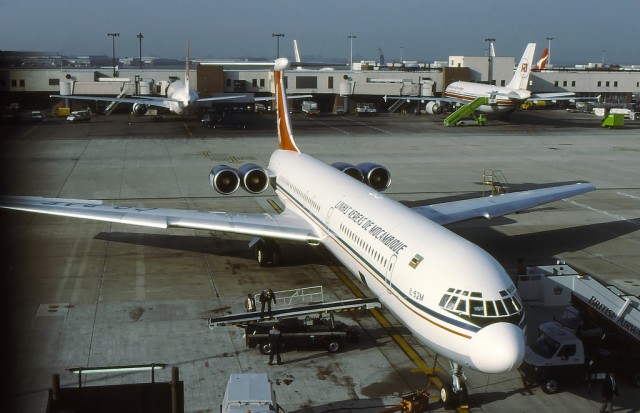
LAM Ilyushin Il-62 – Photo: Colin Cooke / Flickr CC
In the Western world, when it comes to aircraft production, it is pretty much common that the aircraft designer is also the manufacturer of said aircraft. For example, in the United States, Boeing, Lockheed, and McDonnell Douglas were the three big manufacturers of civil aircraft through the 1990’s. All three of these companies employed many thousands of engineers designing every part of each aircraft family, and then would hand the design over to many thousand more factory workers who would build the aircraft at vast company-owned factories. In the former Soviet Union (USSR), things worked a little differently.
When one thinks of Soviet-era aircraft, one normally thinks of the very popular civil designs by Ilyushin and Tupolev. But what most do not realize is that these famous companies were not in the business of aircraft manufacturing. Within the Soviet Union, the aviation industry was governed by three main government organizations: the Ministry of Aviation Industry (МиниÑтерÑтво авиационной промышленноÑти, or MAP), the Ministry of Civil Aviation (МиниÑтерÑтво гражданÑкой авиации, or MGA), and the Ministry of Defense (МиниÑтерÑтво обороны, or MO).
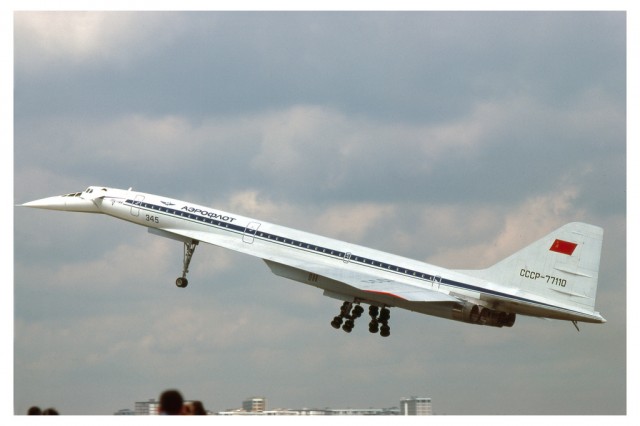
A Tupolev Tu-144 flying – Photo: clipperartic / Flickr CC
The MAP was the state entity that oversaw all aircraft production, both civil and defense, and was split into two main groups: the independent production factories, and the designer’s prototype factories. The MGA, which during the time of the Soviet Union was pretty much Aeroflot, oversaw the repair and upkeep of civil aircraft, while the MO oversaw the repair.
In the Soviet Union, the design firms, call an OKB (short for Опытное конÑтрукторÑкое бюро, or Experimental Design Bureau), employed the engineers who designed the various aircraft. Then once the design work was completed, the People’s Commissariat of Aviation Industry of the USSR (Ðародный комиÑÑариат авиационной промышленноÑти CCCP) or NCAP (itself a part of the MAP), would hand the design off to one of the many aviation factories throughout the USSR. Many times, multiple factories would build the same design, depending on demand for the type.
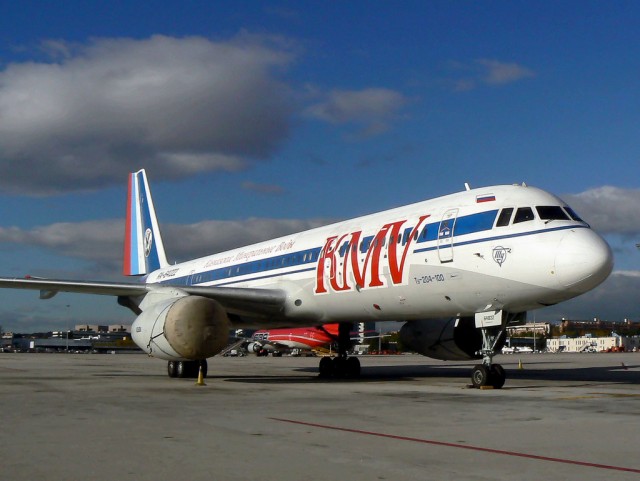
A KMV Tupolev Tu-204 – Photo: joseluiscel / Flickr CC
How the NCAP divided up the work was based upon the availability of work, and the type of aircraft to be assembled. Upon the collapse of the Soviet Union, this model has pretty much remained, except for the fact that the OKBs now work more closely with the factories, and for the most part, have a say in who builds what. Prime example of that is with Sukhoi and the SuperJet. The Sukhoi Design Bureau works very closely with, and manages, the Komsomolsk-on-Amur Aircraft Production Association (KnAAPO), and they chose KnAAPO as the builder for the SuperJet.
This relationship between the design firms and the factories has also led to some interesting aircraft designations. For example, the Tupolev Tu-204 is built by two factories, Aviastar SP in Ulyanovsk and Kazan Aircraft Production Association (KAPO) in Kazan. They both build variants of the Tu-204, but all aircraft built by KAPO are designated Tu-214. Another interesting caveat is that the factories are able to make design changes as they see fit, although they do have help and assistance from the design bureaus.
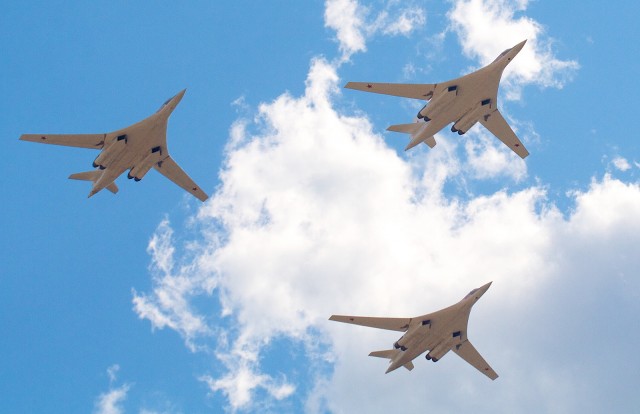
Three Tupolev Tu-160 flying in formation – Photo: Andrey Belenko / Flickr CC
Another difference between Western and Soviet manufacturing is what they built where. In Western aircraft factories, it is very rare to see civil and military aircraft being built side-by-side. Granted, it is not uncommon to see military derivatives of civil designs being built on the same lines (for example, the Boeing 737 and P-8, and the Douglas DC-10 and KC-10), but in the Soviet factories, one would easily find fighters being assembled right next to airliners.
For example, at KAPO, the Tupolev Tu-160 supersonic bomber was built in the same building and right alongside the Tupolev Tu-214. At KnAAPO, the SSJ is built at the same facility that produces the famous Sukhoi Flanker line of fighters such as the Su-27 and Su-30, albeit in a new building that was built especially for the SSJ. The new Irkut MS-21 airliner, currently in development, will be built right alongside the production line that currently builds Su-27s and Su-30s.
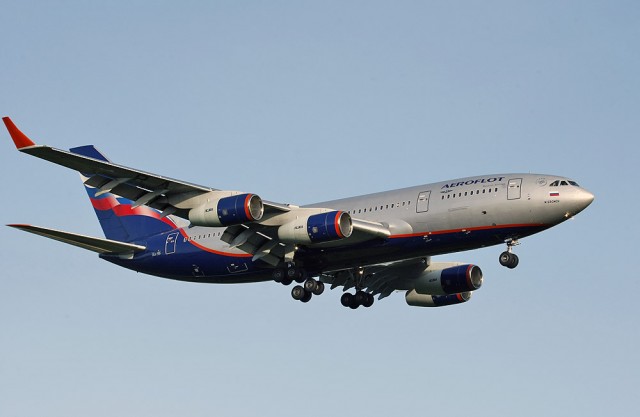
An Aeroflot Il-86 – Photo: mikhail_serbin / Flickr CC
As mentioned earlier, the only main exception to the rule about the OKB’s not building aircraft, and only designing them, came in the very beginning of an aircraft program. Since the designer knew the most about the aircraft in the beginning, it made sense for the design bureau to also build the prototype, since the bureau had already most likely assembled various mock-ups of the design.
The first Ilyushin Il-62, Il-76, and Il-86 were all assembled at Ilyushin’s experimental shops, MMZ #240 (МоÑква машиноÑтроительный завод ’œÐ¡Ñ‚рела’, or Moscow Machine Building Plant ’œStrela’) located next to their main offices at Moscow’s Khodynka Airfield.
At the end of their first flights, they all landed at Zhukovsky Airfield, the Soviet Union’s premier aviation test facility, where all of the OKB’s maintained test facilities. Ilyushin was not alone in this practice, although they were afforded the luxury of flying their prototypes out of an adjacent runway.
Tupolev, with its head offices in the Lefortovo District of Moscow, assembled the prototypes of the Tu-104, Tu-114, Tu-124, Tu-144, Tu-204, and many of their large military aircraft at their workshops adjacent to their offices at their MMZ #156 (МоÑква машиноÑтроительный завод “опыть”, or Moscow Machine Building Plant ’œOpyt’). However, with no airfield nearby, all of these aircraft were transported in pieces to Zhukovsky, and assembled in the Tupolev hangars.
You might look at the list of Tupolev prototypes (down below) that were assembled in Lefortovo, and are thinking that I left a few out, right? Well, that is correct! The first Tu-134 was assembled at Kharkov in the Ukraine SSR, and the first Tu-154 was assembled in Samara. Yakovlev also had a presence in Moscow at Khodynka Airfield, with their MMZ #115 (МоÑква машиноÑтроительный завод “СКОРОСТЬ”, or Moscow Machine Building Plant ’œSkorost’), where the prototypes for the world’s first regional airliner, the Yak-40, and its follow on design, the Yak-42 were built.
This relationship where the OKB would hand the design off to a separate, state controlled, factory did have a couple of exceptions. For example, the infamous Mikoyan OKB was closely aligned with MMZ #30 (МоÑковÑкий машиноÑтроительный завод “Ð—Ð½Ð°Ð¼Ñ Ñ‚Ñ€ÑƒÐ´Ð°”, or Moscow Machine Building Plant ’œBanner of Labor’), manufactured many of the lineup of MiG fighters, from the early MiG-15 to the modern MiG-29.
Mikoyan also operates an extension of MMZ #30 in the town of Lukhovitsy, roughly 80 miles southeast of their head offices at Khodynka. Mikoyan is also heavily aligned with the SOKOL factory in Nizhny Novgorod (formerly known as Gorky).
The one major manufacturer that has yet to be mentioned is Antonov. Based in Kiev, Ukraine, Antonov was left separated from the rest of the former Soviet OKBs. However, most of the Antonov designs were manufactured in the former Ukraine SSR. The Antonov KMZ #573 (КиевÑкий машиноÑтроительный завод, or Kievski Machine-building Plant) manufactured most of the prototypes for the Antonov transports in Kiev. The minor manufacturers left are LET and PZL. LET, also known as Let Kunovice, was not given an OKB designation, since it was a Czech company, and thus not a formal part of the USSR. However, LET did build a number of their successful L410 commuter turboprop aircraft at their Kunovice factory.
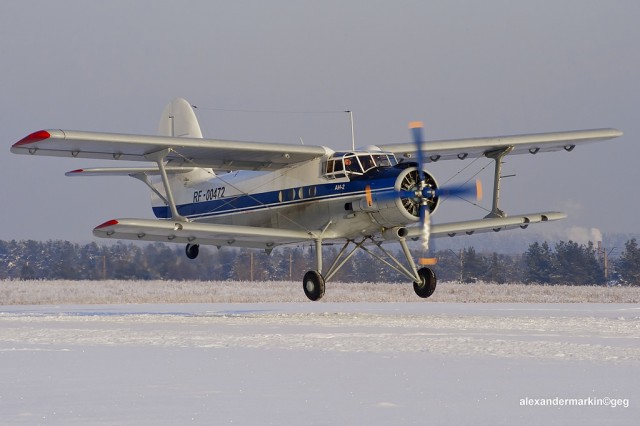
Antonow AN-2 – Photo: Aleksander Markin \ Flickr CC
PZL, which is really three separate Polish companies, stands for PaÅ„stwowe ZakÅ‚ady Lotnicze, or State Aviation Works. In no particular order, the PZLs are PZL Warszawa-OkÄcie, (based in Warsaw, and now owned by EADS CASA), PZL Mielec (based in Mielec, and now owned by the Sikorsky Division of United Technologies), and finally PZL Åšwidnik (based in Åšwidnik, and now owned by AugustaWestland).
Of the three of these, only PZL Mielec produced transport category aircraft. Under the Warsaw Pact, PZL Mielec was the largest producer of the venerable Antonov An-2, and also currently produces a version of the An-28 known as the PZL M28. PZL Mielec was also Poland’s largest aircraft manufacturer. PZL Åšwidnik was primarily a helicopter manufacturer, and manufactured the Mi-1 and Mi-2 for both military and civilian purposes.
Another interesting feature about the aircraft factories is that many of them were located several miles from the nearest airfield. For example, Aviastar-SP in Ulyanovsk is located 8 miles west of Vostochny Airport, and is connected to the airfield by an 8.3 mile long dedicated road, along which the newly assembled aircraft are towed.
Other factories that shared this trait are Sokol in Nizhny Novgorod, Severny Polyot Aircraft Factory in Omsk, Tashkent Aviation Production Association in Tashkent, Saratov Aviation Plant in Saratov, and Tbilaviamsheni Aircraft Production Association in Tbilisi. The reasoning behind this is unclear, but one has to wonder if it was partially to try and hide the production facilities in the case of war. However, it seems to be unlikely, since Western intelligence agencies most likely new the locations of these facilities anyways.
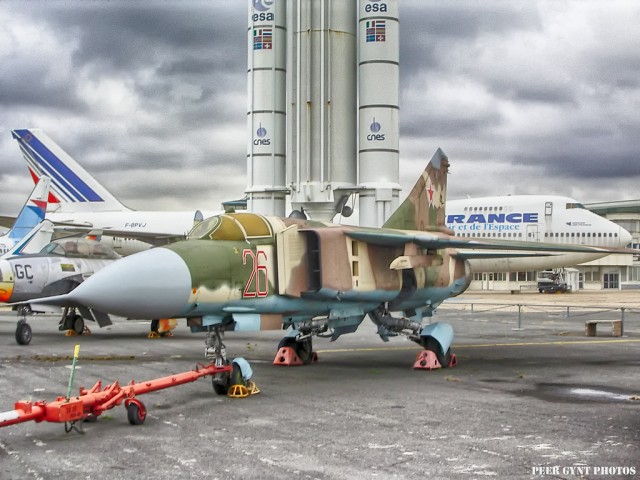
A MiG 23 – Photo: Andrey Korchagin / Flickr CC
A listing of Soviet Aircraft Manufacturing facilities
This list only includes the factories that were located within the geographic borders of the USSR, and includes both civilian and military production.
Moscow Aircraft Production Organization MAPO ’“ Moscow (Khodynka)
Sukhoi , Illyushin, MiG, Yakovlev Head offices
– Il-14, Il-28, Yak-26, Il-18, MiG-21, Il-20, Il-22, Il-38, MiG-23, MiG-29 (Prototypes: Il-14, Il-62, Il-76, Il-86, Il-114)
Tupolev Lefortovo Factory- Moscow
Tupolev Head Office
– Prototypes (built, then trucked to Zhukovsky for assembly and flight) Tu-95, Tu-142, Tu-104, Tu-110, Tu-114, Tu-116, Tu-126, Tu-124, Tu-144, Tu-160, Tu-204
Tushino Machine Building Enterprise ’“ Moscow
– Sukhoi T-4, Buran
Khrunichev State Research and Production Space Center
– Tu-4, Mi-6, M-4, 3M, M-50; Proton, various spacecraft, Prototype Il-28
Dolgoprudny Aircraft Production ’“ Moscow
-An-2
Mil Moscow Helicopter Plant PANKI ’“ Tomilino ’“ Moscow
-Mi-2, Mi-6, Mi-8, Mi-10, Mi-12/V-12, Mi-28, Mi-34
LAPIK ’“Lukhovitsy
-Il-28, MiG-23, MiG-27, MiG-29, Su-29, Su-31, Aviatika 890, Il-103
Voronezh Aircraft factory VASO ’“ Voronezh
-An-10, An-12, Il-28, Tu-16, Tu-123, Tu-128, Tu-143, Tu-144, Il-86, Il-96 , An-148
Nizhny Novgorod Aircraft Factory SOKOL (Gorki)’“ Nizhny Novgorod
-MiG-15, MiG-17, MiG-19, MiG-21, MiG-25, MiG-29UB, MiG-31, M-101T, Yak-130
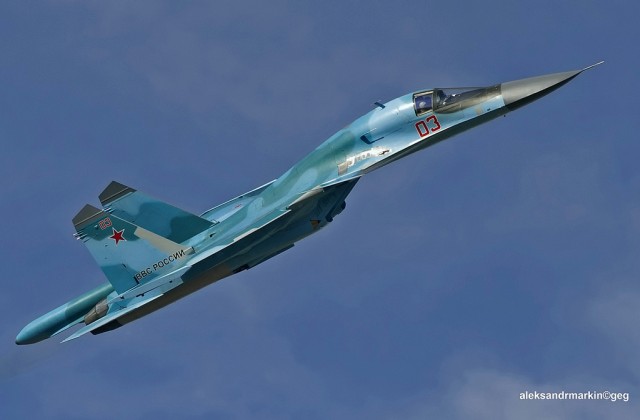
Su-34 flying – Photo: Aleksander Markin / Flickr CC
Sukhoi V.P. Chkalov Novosibirsk Aviation Plant ’“ Novosibirsk
-MiG-15, MiG-17, MiG-19, Yak-28P, Su-7, Su-9, Su-11, Su-15, Su-24, Su-34, An-38
Aviakor plant ’“ Samara
-Tu-4, Tu-95, Tu-114, Tu-116, Tu-126, Tu-142, Tu-154, Molniya 1, An-140
TsSKB Progress ’“ Samara
-MiG-9, MiG-15, MiG-17, Tu-16; Vostok, Voskhod, Soyuz, Molniya, N-1, Energiya
KnAAPO Komsomolsk-on-Amur Aircraft Production Association – Komsomolsk-on-Amur
-Li-2, MiG-15, MiG-17, Su-7, Su-17, Su-20, Su-22, Su-27, Be-103, Su-30MKK, Su-80, SSJ
KAPO Kazan Aircraft Production Association ’“ Kazan
-Tu-4, Tu-16, Tu-104, Tu-22, Tu-22M, Il-62, Tu-160, Tu-214
Kazan Helicopter Plant ’“ Kazan
-Mi-1, Mi-4, Mi-8, Mi-9, Mi-14, Mi-17, Ansat, Aktai, Mi-38
Rostov-on-Don Helicopter Plant ROSTVERTOL – Rostov-on-Don
-Yak-14, Mi-1, Mi-6, Mi-10, Mi-24, Mi-26, Mi-28
Ulan-Ude aircraft plant ’“ Ulan-Ude
-Ka-15, Ka-18, Yak-25RV, Ka-25, Mi-8, Mi-17, MiG-27, Su-25, Su-39, An-24
CJSC Aviastar-SP ’“ Ulyanovsk
-An-124, Tu-204, Il-76MD-90A
Progress Arsenyev Aviation Company ’“ Arsenyev
-Yak-18, Yak-50, Yak-52, An-14, Mi-24, Mi-34, Ka-50, Ka-52, SP-55
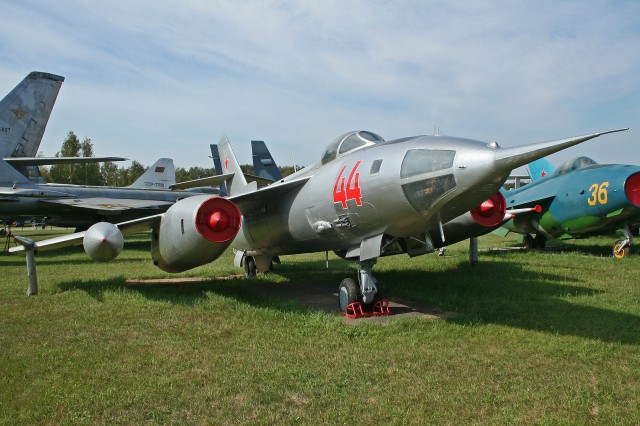
A Yak-28 on display – Photo: Alan Wilson / Flickr CC
Irkutsk Aviation Plant ’“ Irkutsk
-Tu-14, Il-28, An-12, Yak-28, An-24T, MiG-23U, MiG-27, Su-27UB, Su-30MKI, Yak-112, Su-34, Be-200
TAPOiCh Tashkent Aviation Production Association ’“ Tashkent
-Li-2, Il-14, An-8, Ka-22, An-12, An-22, Il-76, Il-114
Smolensk Aviation Plant ’“ Smolensk
–Yak-12, Yak-18T, La-17, Yak-42, M-55, SM-92,
Saratov Aviation Plant ’“ Saratov
-Yak-11, La-15, Mi-4, Yak-25, Yak-27, Yak-40, Yak-38, Yak-42, Yak-54
JSC Tbilaviamsheni ’“ Tibilisi
-Yak-15, Yak-17, Yak-23, MiG-15, MiG-17, La-17, MiG-21U, Su-25
KhAPO Kharkiv State Aviation Production Enterprise ’“ Kharkov
-Yak-18, MiG-15UTI, Tu-104, Tu-124, Tu-134, Tu-141, An-72/74, An-140
Kyiv Aviation Plant Aviant ’“ Kiev
-An-2, An-24, An-26, An-30, An-32, An-124, An-148, An-225 (Prototypes: An-8, An-10, An-28, An-70, An-72, An-140)
Omsk-Severny Polyot Aircraft Factory ’“ Omsk
-Il-28, Tu-104, An-74, An-3, R-12, R-16, 8K84, Kosmos
Taganrog Aircraft Production ’“ Taganrog
-Be-6, Be-10, Be-12, Tu-95, Tu-142, A-40, A-50, Be-200
KumAPP Kumertau Aviation Plant ’“ Kumertau
-Ka-26, Tu-143, M-17, Ka-27, Ka-29, Ka-32, Ka-226
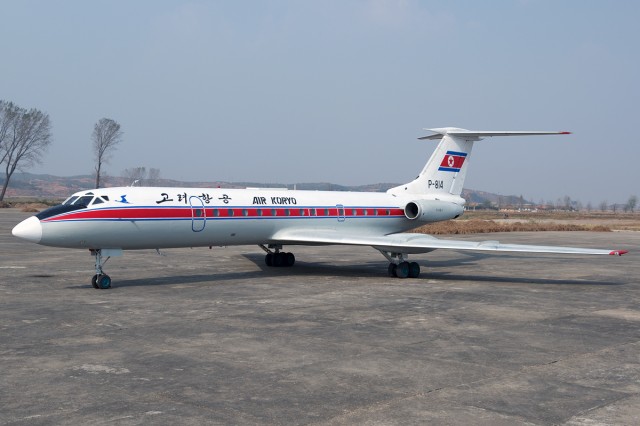
the caption on the Aeroflot Il-86 should read Aeroflot Il-96
This is a great lesson on Soviet era aviation. I have a question on one of the points you made. Why were military aircraft and civilian aircraft built on the same production line in the Soviet era?